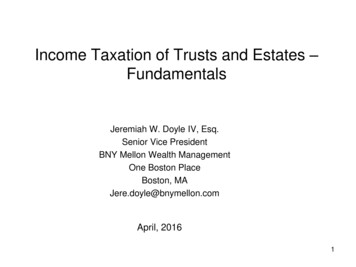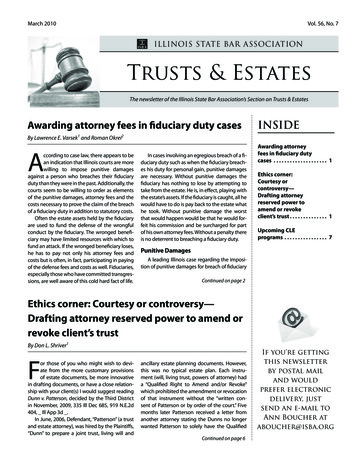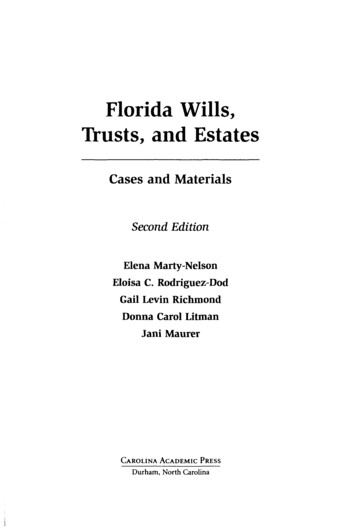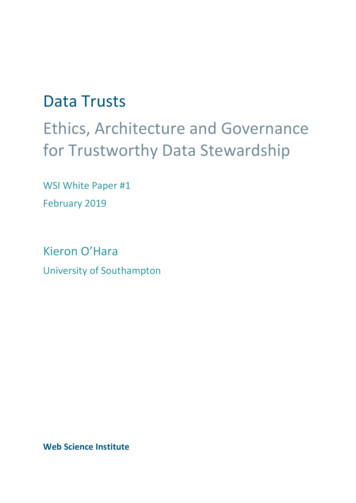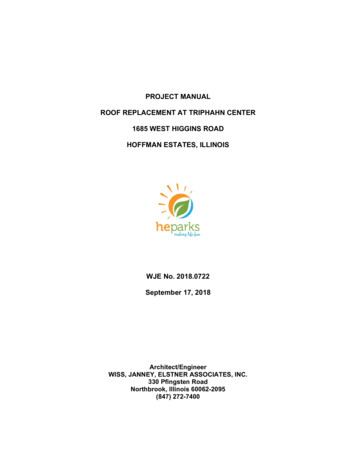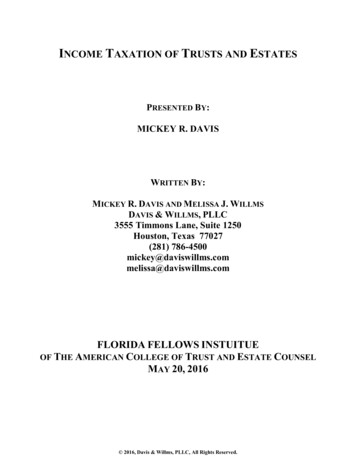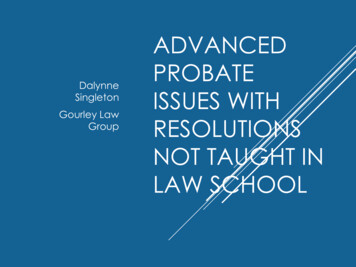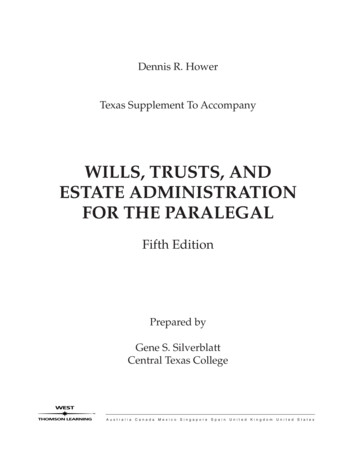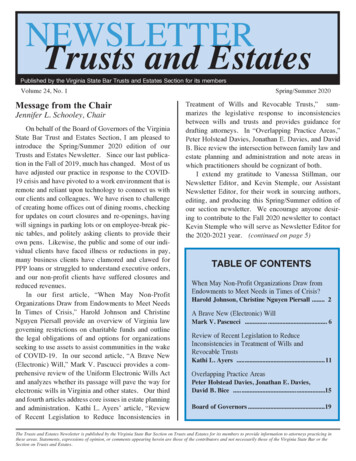
Transcription
NEWSLETTERTrusts and EstatesPublished by the Virginia State Bar Trusts and Estates Section for its membersVolume 24, No. 1Message from the ChairJennifer L. Schooley, ChairOn behalf of the Board of Governors of the VirginiaState Bar Trust and Estates Section, I am pleased tointroduce the Spring/Summer 2020 edition of ourTrusts and Estates Newsletter. Since our last publication in the Fall of 2019, much has changed. Most of ushave adjusted our practice in response to the COVID19 crisis and have pivoted to a work environment that isremote and reliant upon technology to connect us withour clients and colleagues. We have risen to challengeof creating home offices out of dining rooms, checkingfor updates on court closures and re-openings, havingwill signings in parking lots or on employee-break picnic tables, and politely asking clients to provide theirown pens. Likewise, the public and some of our individual clients have faced illness or reductions in pay,many business clients have clamored and clawed forPPP loans or struggled to understand executive orders,and our non-profit clients have suffered closures andreduced revenues.In our first article, “When May Non-ProfitOrganizations Draw from Endowments to Meet NeedsIn Times of Crisis,” Harold Johnson and ChristineNguyen Piersall provide an overview of Virginia lawgoverning restrictions on charitable funds and outlinethe legal obligations of and options for organizationsseeking to use assets to assist communities in the wakeof COVID-19. In our second article, “A Brave New(Electronic) Will,” Mark V. Pascucci provides a comprehensive review of the Uniform Electronic Wills Actand analyzes whether its passage will pave the way forelectronic wills in Virginia and other states. Our thirdand fourth articles address core issues in estate planningand administration. Kathi L. Ayers’ article, “Reviewof Recent Legislation to Reduce Inconsistencies inSpring/Summer 2020Treatment of Wills and Revocable Trusts,” summarizes the legislative response to inconsistenciesbetween wills and trusts and provides guidance fordrafting attorneys. In “Overlapping Practice Areas,”Peter Holstead Davies, Jonathan E. Davies, and DavidB. Bice review the intersection between family law andestate planning and administration and note areas inwhich practitioners should be cognizant of both.I extend my gratitude to Vanessa Stillman, ourNewsletter Editor, and Kevin Stemple, our AssistantNewsletter Editor, for their work in sourcing authors,editing, and producing this Spring/Summer edition ofour section newsletter. We encourage anyone desiring to contribute to the Fall 2020 newsletter to contactKevin Stemple who will serve as Newsletter Editor forthe 2020-2021 year. (continued on page 5)TABLE OF CONTENTSWhen May Non-Profit Organizations Draw fromEndowments to Meet Needs in Times of Crisis?Harold Johnson, Christine Nguyen Piersall . 2A Brave New (Electronic) WillMark V. Pascucci . . 6Review of Recent Legislation to ReduceInconsistencies in Treatment of Wills andRevocable TrustsKathi L. Ayers . 11Overlapping Practice AreasPeter Holstead Davies, Jonathan E. Davies,David B. Bice .15Board of Governors.19The Trusts and Estates Newsletter is published by the Virginia State Bar Section on Trusts and Estates for its members to provide information to attorneys practicing inthese areas. Statements, expressions of opinion, or comments appearing herein are those of the contributors and not necessarily those of the Virginia State Bar or theSection on Trusts and Estates.
Spring/Summer 2020Trusts & Estates NewsletterWhen May Non-Profit Organizations Draw fromEndowments to Meet Needs in Times of Crisis?By Harold Johnson and Christine Nguyen PiersallGiven the economic uncertainty caused byCOVID-19, charitable organizations may see a significant decrease in donations in the coming monthsand years. Such reductions in giving will make it difficult for charitable entities to fund their operations.At the same time, the pandemic is causing increaseddemand for charitable programs and services incommunities throughout the Commonwealth. Thisincreased demand may push charitable organizationsto devote more of their resources to meet the current needs of the communities they serve, whetherby spending down the principal of endowments orby directing such funds to a new purpose in order tomeet an acute need in the community.Though laudable, the desire to address acute needsin the community must be balanced with thoughtfuldeliberation by the custodians of charitable assets.Before seeking to spend down the principal of anendowment or to alter the charitable purpose ofdonated funds, organizations must carefully reviewthe restrictions placed on specific endowment fundsand be mindful of applicable law regarding the maintenance and deployment of charitable endowments.This article provides an overview of Virginia lawgoverning the restrictions on charitable funds with thegoal of helping organizations better understand theirlegal obligations and their options for using assets toassist communities in crisis as a result of COVID-19.§2.2-507.1. Given this element of “public trust,” theAttorney General of Virginia has both the authorityand the responsibility to make sure that a charitableinstitution maintains and expends restricted gifts andfunds in accordance with the intent for which suchgifts were made. Id.The Attorney General’s authority over theassets of a charitable corporation is further definedby Virginia’s version of the Uniform PrudentManagement of Institutional Funds Act (“UPMIFA”).VA. Code §64.2-1100, et seq. UPMIFA establishesguidelines for a charitable institution’s managementand expenditure of endowment funds, and it sets forththe mechanisms by which restrictions on endowmentfunds can be released.What is an “endowment fund”?Under UPMIFA, an “institutional fund” is broadly defined to include any fund held by an organization“exclusively for charitable purposes.”1 Id. UPMIFAdefines “endowment fund” as a fund that, under theterms of a gift instrument, is not wholly expendableby the institution on a current basis.2 Id. In otherwords, an endowment fund is any fund that is established for a particular use and cannot be spent on aninstitution’s general operations.Notably, the rules for releasing restrictions on anendowment fund under UPMIFA apply only wherea donor gives funds to the institution with certainrestrictions or for a specific purpose. Where aninstitution itself designates unrestricted funds for aspecific purpose (such as “Board-restricted funds” or“quasi-endowment funds”), those funds are not subject to the rules and limitations of UPMIFA, and theinstitution can unilaterally redirect the use of those“Board-restricted funds.”What statutes control the management of charitable funds in Virginia?In general, the assets of a charitable institutionare held in trust for the public to be used for thepurposes established by the governing documents ofthe charitable institution, the gift made to such charitable institution, or other applicable law. VA. Codepage 2
Spring/Summer 2020Trusts & Estates NewsletterHow can restrictions on an endowment fund bereleased or modified?UPMIFA provides specific guidance regarding acharitable institution’s ability to re-purpose restrictedgifts. VA. CODE § 64.2-1104.First, the restrictions on any endowment fund maybe released if the institution obtains written consentfrom the original donor(s) of such funds. Of course,it is not unusual for multiple donors to support asingle endowment fund. While no Virginia caseshave considered or decided what rules apply in suchcircumstances, caution dictates that all of the donorsto a single fund must provide written consent inorder to redirect that fund to another purpose. Evenwhere such consent is obtained, the new purpose towhich such funds are directed must be within thegeneral charitable purpose of the institution. (Thus,for example, a fund established to provide support tovictims of domestic violence cannot be redirected toprovide support for the arts or to open a shelter forlost animals.)Where the institution is unable to obtain donorconsent (because one or more donors are deceased orwill not provide consent), an institution may seek torelease or modify a restriction upon an endowmentin one of three ways. The appropriate mechanismfor seeking such release or modification generally depends upon the size and age of the fund inquestion. Notably, the release or modification of arestricted fund is not simply a matter of the institution determining, in the exercise of its discretion,that the money could be better spent in another manner. Rather, each of the mechanisms for release ormodification of a restricted endowment requires theinstitution to demonstrate that the purpose or restriction on the endowment fund has become unlawful,impracticable, impossible or wasteful.be provided in writing, and it should informthe Attorney General of the fund’s history,its purpose and the nature of the proposedexpenditures or modifications. If the AttorneyGeneral does not object to such modificationwithin 60 days, then the institution can implement the modification and put the funds toanother use, so long as that use is consistentwith the charitable purposes expressed in thegift instrument.b. Funds under 250,000 - Consent of theAttorney General. For funds with an aggregate current market value of 50,000 or morebut less than 250,000, an institution mayrequest the Attorney General to consent tothe modification of the particular purpose orrestriction on the use of the fund. Again, thefunds must be redirected in a manner consistent with the charitable purposes expressed inthe gift instrument.c. Any and All Funds – Court Order. Aninstitution’s final option, which is requiredfor endowment funds of 250,000 or more,is to petition the local circuit court to modifythe restrictions on such funds and authorizethe funds to be put to another purpose consistent with the charitable purposes expressedin the gift instrument. The institution mustnotify the Attorney General of its filing of thepetition for modification, and the AttorneyGeneral must have an opportunity to be heardby the court before the court renders its decision. Thus, while not required for such funds,it makes sense to seek the Attorney General’sconsent to a proposed modification before filing a petition in circuit court.a. “Small and Old Funds” - Notice to theAttorney General. For funds establishedmore than 20 years ago, and with an aggregatecurrent market value of less than 50,000, theinstitution can simply notify the Office of theAttorney General of its intent to release ormodify the particular purpose of or restriction on the fund. Such notification shouldWhat are the practical steps that charitable institutions should undertake when seeking release ormodification of endowment funds?Again, under any of the above mechanisms forrelease or modification of a restricted endowmentfund, the institution must demonstrate that the restricpage 3
Spring/Summer 2020Trusts & Estates Newslettertion on the endowment fund has become unlawful,impracticable, impossible or wasteful. These termsare not defined in UPMIFA, and they are generallyleft to the discretion of the Attorney General or court.For practical purposes in the context of the COVID19 pandemic, this requirement likely means that acharitable institution will have to convince either theAttorney General or a court that a community’s specific need is so great that the continued preservationof the restrictions on an endowment fund would bewasteful. Alternatively, if decreased donations putthe charitable organization’s existence at risk, theorganization may persuade the appropriate authoritythat the continued restrictions on the use of an endowment fund would be impracticable or impossible.For example, a charity will not be able to meet thepurpose of an endowment fund if the charity itselfbecomes insolvent and cannot pay its bills.It is also worth noting the requirement in UPMIFAthat, where restrictions are released or modified, thefunds should be directed to a use “consistent withthe charitable purposes expressed in the gift instrument.” This means that any request to the AttorneyGeneral or court for a release or modification offunds should include a discussion of the charitableinstitution’s planned use of such funds. The AttorneyGeneral and/or court will be far more likely to authorize the release or modification of a restriction if itcan determine that the alternate use of such fundsis appropriate and within the general mission of theinstitution. Thus, the charitable institution should beprepared to provide some level of detail regardinghow any restricted endowment funds could be put tobetter use in the present pandemic when approaching the Attorney General or court with such requests.Rather than simply asking to have restricted endowment funds released to be treated as unrestricted, therequests to the Attorney General and/or court shouldprovide some examples of how those funds would bespent once modified.Under normal circumstances, a charitable institution should contact the Attorney General (throughhis deputy staff) and arrange a meeting to explainwhy the release or modification of restrictions onan endowment fund is warranted. Such a meetingcan be invaluable in laying the groundwork for theformal paperwork and consents to follow. However,given the confines of social distancing, remote working and the demands on personnel both at charitableorganizations and within the Office of the AttorneyGeneral, arranging such meetings may be difficult.Therefore, written communications with the Office ofthe Attorney General should be thorough and shouldinclude copies of pertinent paperwork related to theendowment in question, such as donative instrumentsor other documents governing the management andexpenditure of the fund.If an entity has multiple endowments that itwishes to modify and/or spend down, it is easiest toplace those selected endowment funds into categoriesor “buckets” based on the different mechanisms forreleasing restrictions under UPMIFA. Namely, theendowment funds should be classified as:1. Funds with living donors who consent tomodification of the fund; and2. Funds without living or consenting donors:a. Small and Old funds;b. Funds of 50,000 or more and less than 250,000; andc. Funds of 250,000 or more.For the “living donor” funds, the charitableinstitution should seek to obtain written consentssigned by those donors. The written consents shouldidentify the need for a release of the restrictions ona given fund. If possible, and to avoid confusion orsubsequent objections from living donors, the writtenconsents should include a statement of the purposesto which the funds will be put upon the release of anyrestrictions.For the “Small and Old” funds where donor consent is not feasible, the charitable institution shouldprepare individual letters to the Attorney General’soffice regarding each such fund. The letters shouldidentify the need for a release of the restrictions onsuch funds and include a statement of the purposesto which the funds will be put upon the release ofany restrictions. Rather than waiting 60 days for theexpiration of the Attorney General’s opportunity toobject to such releases, the charitable institution maywant to be proactive and ask the Attorney Generalpage 4
Spring/Summer 2020Trusts & Estates Newsletterto consent to the release or modification prior to the60-day deadline.For funds containing less than 250,000 wheredonor consent is not feasible, the charitable institution should prepare individual letters to the AttorneyGeneral’s office along the same lines as the lettersregarding “Small and Old” funds above. However,such letters must seek the Attorney General’s consent, as there is no automatic release of restrictionsafter 60 days.For funds valued at 250,000 or more, the charitable institution must prepare a petition to the courtseeking release of the restrictions on each suchfund. Prior to filing such petition with the court, thecharitable institution should send a copy of the petition to the Attorney General and solicit the AttorneyGeneral’s consent to the requested modifications.The court-approval process will be much smoother ifthe Attorney General is on board with the release ormodification of restrictions prior to the petition beingfiled.The COVID-19 pandemic has created acute needsand crises of various types in almost every community in Virginia. The economic uncertainty caused byeconomic shutdowns brings great risk for charitableinstitutions. A thoughtful and deliberate approachthat takes into account the mandates of Virginia lawmay allow charitable organizations to continue serving their missions in these trying times. S(Endnotes)1. This does not include “program related assets” such asbuildings or other physical property used to accomplish theorganization’s charitable purpose. Id.2. UPMIFA provides that, under certain circumstances, aportion of the income earned on an endowment fund will notbe subject to the endowment’s restrictions and may be directedtoward an institution’s general operations. Further analysis ofthat issue is beyond the scope of this article. S(Chair Message Continued from page 1)Before closing this introduction to the newsletter and completing my year as Chair of our section,I must express my utmost gratitude to the lawyerswho assisted with our section’s major initiative of theyear: to provide an additional topical resource to thepublic on managing the probate process. Many ofyou may be aware that our section maintains “Willsin Virginia” on the VSB website. We are now on thecusp of adding “Overview of Probate in Virginia” toprovide general information to members of the publicon the probate process. Countless hours were spentcreating this publication by Ellis Pretlow and BrookeTansill, who responded to my call to volunteer, alongwith Scott Golightly and Mark Pascucci, members ofthe Board of Governors of our section, and VanessaStillman and Kevin Stemple, our section’s editors.My heartfelt thanks is given to each of them for takinginterest in and playing an integral role in producingthe content, and to Scott Golightly for editing andcoalescing the various authors’ contributions. Thepublication may be found at vsb.org/site/publications/publications-home.Harold (“Hal”) Johnson is co-chair of Williams Mullen’sEducation Practice, where he works with educationalinstitutions on various matters, including endowmentmanagement and the Uniform Prudent Management ofInstitutional Funds Act (UPMIFA). Hal received both hisBachelor of Arts and his Juris Doctor from the Universityof Virginia.Jennifer L. SchooleySection Chair SChristine Nguyen Piersall is chair of William Mullen’sEstate Planning: Private Client & Fiduciary ServicesPractice, where she focuses her practice primarily onestate tax planning, estate and trust taxation and administration. Christine serves as counsel to and on the Boardof several non-profit organizations. Christine received herBachelor of Arts from the University of Virginia and herJuris Doctor from the University of Richmond. Xpage 5
Spring/Summer 2020Trusts & Estates NewsletterA Brave New (Electronic) WillBy Mark V. PascucciWill the passage of the Uniform Electronic WillsAct pave the way for electronic wills in Virginia andother states?in the presence of two witnesses. He then printedthe will (which contained his typed signature) andthe two witnesses signed the hard copy. The will wasdeemed valid.3In a 2013 Ohio case, a will was typed on aSamsung Galaxy tablet and electronically signedby the testator and two witnesses using the tablet’sstylus. The will (as saved on the tablet) was deemedvalid and met the statutory requirement to be “in writing.”4In a 2018 Michigan case, the testator committedsuicide – and left a handwritten note directing therecipient to an electronic note on his phone titled“Last Note.” The note included directions for disposing of his property, and was deemed a valid willunder Michigan’s harmless error statute.5Covid-19 update: Since this article was written, thepandemic has caused Virginia practitioners to reviewand wrestle with Virginia’s requirements for executing estate planning documents. The issues include:paper & ink execution vs. electronic execution, physical witness presence vs. electronic witness presence,and in-person notarization vs. remote notarization.Further muddying the water – Virginia has an electronic notary statute but no electronic Wills statute.The legislative committee of the VBA (Wills, Trusts& Estates section) is aware of this and an “e-wills”statute is on its agenda for review.States Passing E-wills LegislationStates have been active in recent years in passinge-wills legislation. Nevada, far ahead of the curve,was the first state to modernize the world’s secondoldest profession, passing an e-wills statute in 2001(which it revised in 2017).6 Recently, Florida,Indiana and Arizona have also passed e-wills legislation. (Indiana’s statute also references electronicpowers of attorney and trusts).7 A number of otherstates have also considered e-wills legislation, including Virginia, New Hampshire, Texas and the Districtof Columbia.Courts Approving Various Electronic Writings asWillsFor better or worse, we are living in an age oftechnology. At our fingertips we have computers,smartphones, tablets and other devices. An estimated8 billion devices are now connected to the Internet,and Netflix binging has reached 250 million hoursper day.1 (In case you’re curious, the most-watchedshow in Netflix history is currently 6 Underground,at 83 million views.)2The ease and convenience of these devices havegiven rise to the creation of electronic records purporting to be wills. Below are a few examples wherecourts have considered such records.In a 2003 Tennessee case, the testator used a wordprocessing program (e.g., Microsoft Word) to typehis will. He then typed his signature in cursive font,The Uniform Electronic Wills ActThis trend toward e-wills caused the UniformLaw Commission (the “ULC”) to begin drafting theUniform Electronic Wills Act (the “Act”). The Act,approved at the ULC’s annual meeting in July 2019,page 6
Spring/Summer 2020Trusts & Estates Newsletteris relatively short – 12 sections totaling 19 pages,including comments.8The ULC’s webpage describes the Act’s purpose:The Uniform Electronic Wills Act permitstestators to execute an electronic will andallows probate courts to give electronic willslegal effect . . . Since 2000, the UniformElectronic Transactions Act (UETA) [whichVirginia has enacted at Va. Code Ann. § 59.1479 et seq.] and a similar federal law, E-SIGN,have provided that a transaction is not invalidsolely because the terms of the contract arein electronic format. But UETA and E-SIGNboth contain an express exception for wills . . Under the new Electronic Wills Act, the testator’s electronic signature must be witnessedcontemporaneously . . . States will have theoption to include language that allows remotewitnessing. The act will also address recognition of electronic wills executed under the lawof another state. For a generation that is usedto banking, communicating, and transactingbusiness online, the Uniform Electronic WillsAct will allow online estate planning whilemaintaining safeguards to help prevent fraudand coercion.9proving affidavit must be executed simultaneously.Notably, the Act diverges from traditional willlaw in the timing of the self-proving affidavit;Virginia (and many other states) allow a traditionalwill to be self-proved “at any subsequent date,”10 butthe ULC’s comment to Section 8 of the Act providesthat the Act “does not permit the execution of a selfproving affidavit for an electronic will other than atthe time of execution of the electronic will.” Thisis intended to help mitigate the risk of a fraudulente-will signature. The Act also states that extrinsicevidence may be used to establish the testator’s intentin signing the e-will, e.g., a picture or audio-visualrecording of the testator signing his e-will.What is an electronic signature?What constitutes a “signature” in an electronicdocument? Let’s review the two relevant bodies oflaw: the Act (remember, Virginia has not yet adoptedit) and Virginia’s UETA. The Act’s definition of“sign” broadly provides “to execute or adopt a tangible symbol . . .”11 The comments to Section 5 ofthe Act state that a “typed signature in a cursive font,or a pasted electronic copy of a signature” would bothsuffice, and “as e-signing develops, other types ofsymbols or processes may be used . . .”Virginia’s UETA defines an electronic signatureas “an electronic sound, symbol, or process attachedto or logically associated with a record and executedor adopted by a person with the intent to sign therecord.”12Key Provisions of the Uniform Electronic WillsActExecution and Self-Proving of Electronic WillsSections 5 and 8 of the Act set forth requirementsfor the execution and self-proving of e-wills; theseecho the formalities of traditional wills.Electronic vs. Physical Presence of WitnessesThe ULC’s drafting committee weighed this issueand decided in favor of ensuring convenience andflexibility with remote attestation. In a draft of theAct dated January 22, 2019, the committee noted afew reasons why the physical presence of witnessesmay not be critical: 1) will substitutes don’t typicallyrequire witnesses (e.g., beneficiary designations);2) law firm employees witness numerous wills andmay be unable to recollect an individual testator’scapacity; and 3) the harmless error doctrine allows acourt to give effect to a will not properly witnessed.13(Virginia has adopted the harmless error doctrine atVa. Code Ann. § 64.2-404).Per the Act, an e-will must:- Be readable as text (no audio wills, no “homevideo” wills);- Be signed by the testator, or on behalf of thetestator by someone in the testator’s physicalpresence; and- Be signed by two witnesses, in either the physical or electronic presence of the testator, or by anotary.In addition, to be self-proving, the e-will and selfpage 7
Spring/Summer 2020Trusts & Estates NewsletterChoice of LawSection 4 of the Act “reflects the policy that a willvalid where the testator was physically located shouldbe given effect using the law of the state whereexecuted. The Act does not require a state to giveeffect to a will executed by a testator using the law ofanother state unless the testator resides, is domiciled,or is physically present in the other state when thetestator executes the will.”Certification of Paper CopySection 9 of the Act allows an individual to reducean electronic will to paper if the individual certifiesthe paper copy is complete, true and accurate. Thisis intended to facilitate the admission of the will toprobate.Electronic Signatures for Revocable TrustsThe Act intentionally does not address revocabletrusts, despite their widespread use as will substitutes.In fact, the ULC drafting committee noted in a draftof the Act that the “UETA does not exclude intervivos trusts, so this Act is limited to wills and doesnot cover inter vivos trusts or other estate planningdocuments.”14Can revocable trusts indeed be signed electronically? The ULC drafting committee appears to thinkso. However, and with due deference to those experts,let’s review the scope of Virginia’s UETA. It provides, “Except as otherwise provided in subsection(b), [which excludes wills, codicils and testamentarytrusts] this chapter applies to electronic records andelectronic signatures relating to a transaction.”15 TheUETA then defines a “transaction” as “an action orset of actions occurring between two or more persons[including trusts] relating to the conduct of business,commercial, or governmental affairs.”16So, Virginia’s UETA validates electronic signatures relating to the conduct of business, commercialor governmental affairs. The UETA’s definition of“persons” does include trusts. But, is the creation ofrevocable trusts a “business” or “commercial” affair?Those terms are not defined in the UETA. Perhaps afuture Virginia e-wills bill should clarify that electronic signatures are also valid for revocable trusts.Example – Choice of LawHarry lives in Massachusetts, a state whichhas not enacted an e-wills statute. Harry, whilein Massachusetts, remotely executes an e-willunder Nevada law. That e-will will be valid inNevada (which allows a remote testator), but not inMassachusetts. However, if Massachusetts enactse-will legislation, Harry’s e-will should then be validin Massachusetts. Alternatively, if Harry had traveledto Nevada and executed an e-will while physicallypresent in Nevada, his e-will should also be valid inMassachusetts, because it was valid in the state inwhich he physically signed the will.What if Harry had been a Nevada resident, executed a valid e-will and then moved to Massachusetts?Massachusetts should give effect to his e-will, becauseit was validly executed when Harry was in Nevada.RevocationLike traditional wills, e-wills may be revoked bya subsequent will or by a “physical act” of revocation upon the e-will. The preponderance standardapplies as to intent to revoke. The Act discusses, butdoes not define, a “physical act,” and it provides afew examples in its comments: deleting a file withthe “click of a mouse,” “smashing a flash drive witha hammer,” requesting a third party custodian of thee-will to delete the e-will, and printing a paper copyof the e-will and writing “revoked” on it.Virginia’s Efforts to Pass E-Wills LegislationTwo e-will bills have been introduced in Virginiathus far. Both predate the Uniform Electronic WillsAct. HB 1643 was introduced by G. Manoli Loupassii
Section on Trusts and Estates. Message from the Chair Jennifer L. Schooley, Chair On behalf of the Board of Governors of the Virginia State Bar Trust and Estates Section, I am pleased to introduce the Spring/Summer 2020 edition of our Trusts and Estates Newsletter. Since our last publica-tion in the Fall of 2019, much has changed. Most of us
